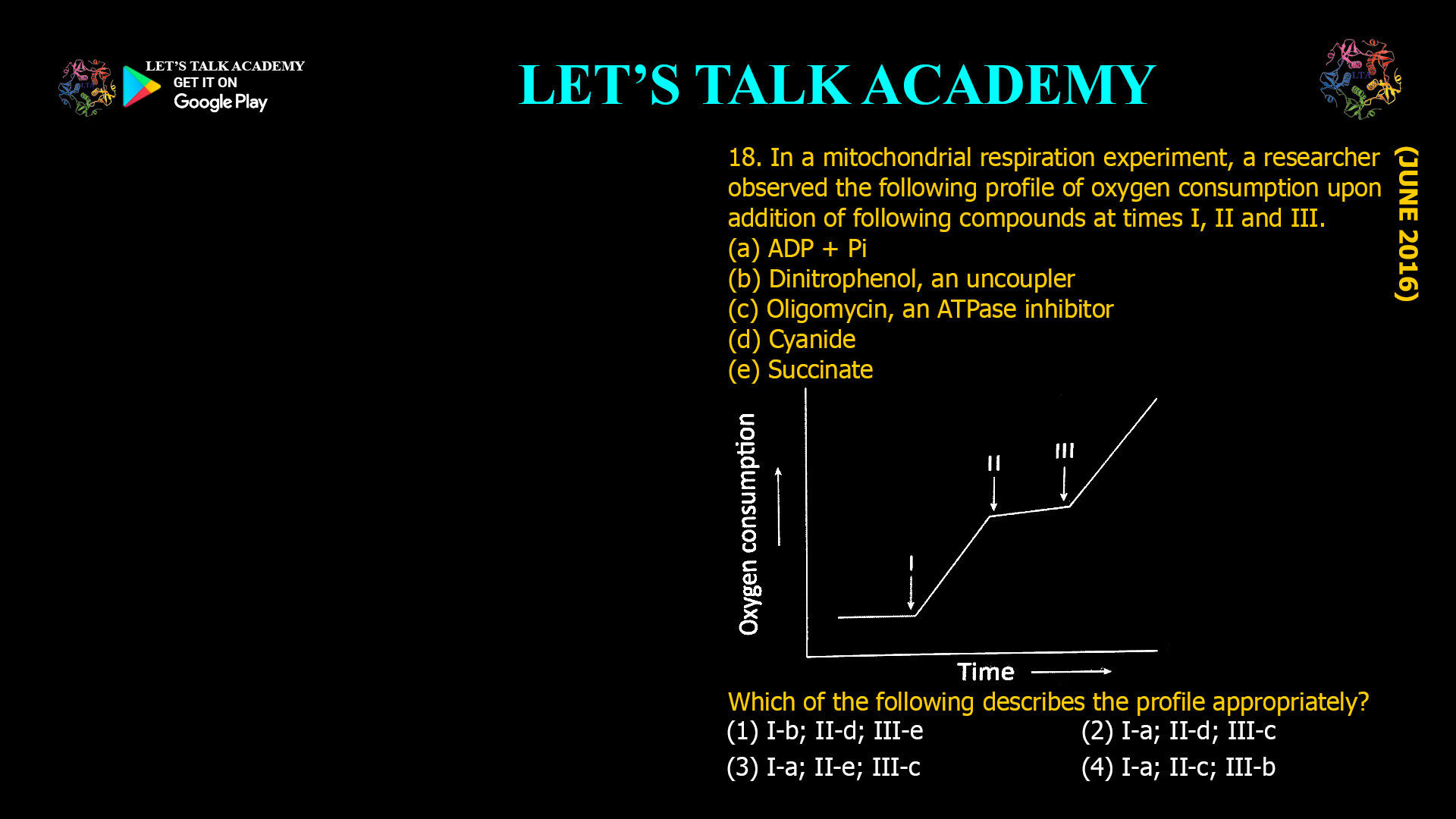18. In a mitochondrial respiration experiment, a researcher observed the following profile of oxygen consumption upon addition of following compounds at times I, II and III.
(a) ADP + Pi
(b) Dinitrophenol, an uncoupler
(c) Oligomycin, an ATPase inhibitor
(d) Cyanide
(e) Succinate

Which of the following describes the profile appropriately?
(1) I-b; II-d; III-e
(2) I-a; II-d; III-c
(3) I-a; II-e; III-c
(4) I-a; II-c; III-b
In mitochondrial respiration experiments, oxygen consumption is measured to assess mitochondrial function and the effects of various compounds on electron transport and ATP synthesis. Different compounds influence oxygen consumption in characteristic ways, allowing researchers to interpret mitochondrial activity.
Key Compounds and Their Effects on Oxygen Consumption
-
ADP + Pi: Stimulates ATP synthesis by providing substrates for ATP synthase, increasing oxygen consumption (State 3 respiration).
-
Succinate: A substrate donating electrons to Complex II, enhancing respiration.
-
Oligomycin: An inhibitor of ATP synthase (Complex V), blocking ATP production and reducing oxygen consumption (State 4 respiration).
-
Dinitrophenol (DNP): An uncoupler that dissipates the proton gradient, increasing oxygen consumption by uncoupling electron transport from ATP synthesis.
-
Cyanide: An inhibitor of Complex IV (cytochrome c oxidase), blocking electron transport and stopping oxygen consumption.
Matching the Profile to Experimental Times
-
Time I: Addition of ADP + Pi stimulates respiration by activating ATP synthesis, increasing oxygen consumption.
-
Time II: Addition of Succinate provides electrons to the chain, further increasing oxygen consumption.
-
Time III: Addition of Oligomycin inhibits ATP synthase, decreasing oxygen consumption by preventing proton flow through ATP synthase.
Evaluating the Options
| Option | Time I | Time II | Time III | Explanation |
|---|---|---|---|---|
| (1) | b (DNP) | d (Cyanide) | e (Succinate) | DNP uncouples, cyanide inhibits, succinate is substrate; order unlikely. |
| (2) | a (ADP + Pi) | d (Cyanide) | c (Oligomycin) | Cyanide inhibits respiration, unlikely at Time II after ADP. |
| (3) | a (ADP + Pi) | e (Succinate) | c (Oligomycin) | Matches expected stimulation by ADP, substrate addition, then ATPase inhibition. |
| (4) | a (ADP + Pi) | c (Oligomycin) | b (DNP) | Oligomycin before uncoupler unlikely; uncoupler usually increases oxygen consumption. |
Conclusion
The most appropriate sequence reflecting typical mitochondrial respiration profiles is:
Time I: ADP + Pi (stimulates respiration)
Time II: Succinate (electron donor substrate)
Time III: Oligomycin (ATP synthase inhibitor, reduces oxygen consumption)
Final Answer:
(3) I-a; II-e; III-c




4 Comments
Pallavi Ghangas
September 23, 2025ADP + Pi (stimulates respiration)
Time II: Succinate (electron donor substrate)
Time III: Oligomycin (ATP synthase inhibitor, reduces oxygen consumption)
Kirti Agarwal
September 24, 2025Opt 3
Roopal Sharma
September 25, 2025AdP +pi ( stimulated respiration)
Succinate is electron donate substrate
Oligomycin – Atp synthase inhibitor , reduce O2 consumption
Kajal
October 4, 2025Option 3